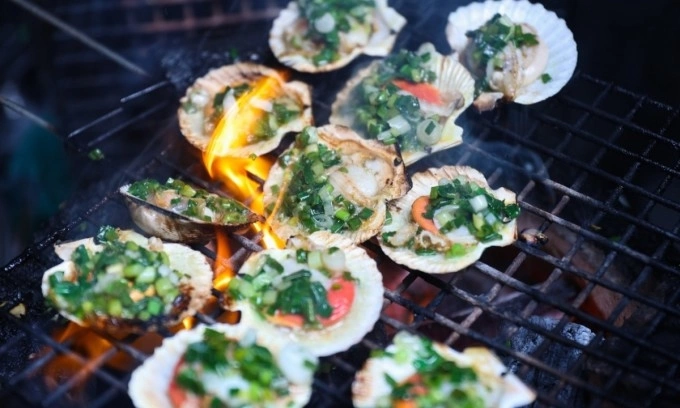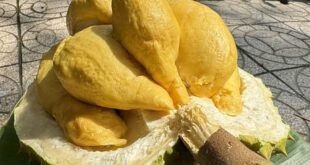Saigon’s rich culinary scene is highlighted by the Ho Chi Minh City Department of Tourism’s recently-released list: “Top 10 most interesting foods for tourists.”
The list of delicious Ho Chi Minh City dishes comes as part of the larger list “Ho Chi Minh City – 100 Interesting Things,” announced by the Department of Tourism in early December. The list is based on more than 104,000 votes across 10 categories, including sightseeing tours, entertainment programs, shopping destinations, accommodation facilities, eateries, cafes, events, and delicacies.
Banh mi
Banh mi is an easy-to-eat, and convenient dish. It features a blend of cold cuts and basic vegetables like coriander, cucumber, pickled carrots, and daikon, paired with condiments inspired by French cuisine, including pate and mayonnaise. In Ho Chi Minh City, banh mi comes with a wide range of fillings, including meatballs, pork skin, fish cake, roasted pork, grilled beef, and shredded chicken.
 |
|
Loaves of banh mi are filled with assorted pork cold cuts and generous servings of pork floss at a shop in District 1. Photo by VnExpress/Bich Phuong |
Many banh mi shops in Ho Chi Minh City boast a history spanning over half a century. Take, for instance, Banh Mi Bay Ho, which first opened its doors in 1930. Located at 19 Huynh Khuong Ninh Street, District 1, after more than 90 years, it still adheres to the same recipe as on its inaugural day.
Another notable establishment is Hoa Ma Banh Mi at 53 Cao Thang Street, District 3, renowned for its combo pan bread. This hot breakfast skillet, a popular morning choice in Saigon, features eggs, sausage, and pate cooked in a pan, served with a baguette, and has been delighting patrons for 60 years.
Other recommended shops worth exploring include:
– Banh Mi Huynh Hoa: 26-30-32 Le Thi Rieng Street, District 1.
– Banh Mi Tang: 822 Nguyen Trai Street, District 5.
– Banh Mi Cu Ly: 189 Hai Ba Trung Street, District 3.
– Banh Mi Sau Le: 423 Nguyen Tri Phuong Street, District 10.
Banh trang tron (Mixed rice paper salad)
Saigon’s mixed rice paper salad is made from dried and finely cut pieces of rice paper. These rice pieces are combined with shredded green mango, chopped laksa leaves, shrimp salt, and a touch of kumquat juice.
 |
|
Mixed rice paper salad comes with a variety of toppings, adding a burst of color. Photo by VnExpress/Huynh Nhi |
For an extra flavor boost, sellers often mix in scallion oil with peanuts and roasted shrimp. The dish does not feel quite complete without the inclusion of quail eggs and beef jerky, and for those who like a bit of heat, extra chili sauce can be added to suit individual tastes. Mixed rice paper delivers a mix of sweet and savory flavors.
When in Saigon, visitors can easily find banh trang tron around spots like Turtle Lake, Nguyen Thuong Hien Street (District 3), September 23rd Park (District 1), the Ben Thanh Market area, and the intersection of Nguyen Thai Hoc – Tran Hung Dao (District 1).
A bag of mixed rice paper salad typically costs between VND25,000 and VND30,000 ($1.03 to $1.23), depending on your choice of toppings.
Banh xeo (crispy pancakes)
In Saigon, where many cultures and regional cuisines intersect, banh xeo is divided into two main types: central-style pancake and Mekong Delta-style pancake. These crispy pancakes are recognized for their golden-brown crust that comes from a batter made with rice flour and water, with a hint of turmeric powder.
 |
|
Banh xeo is commonly accompanied by a dipping sauce and pickles on the side. Photo by VnExpress/Bui Thuy |
The version from central Vietnam is small, less than a hand’s diameter, and is packed with green beans, bean sprouts, seafood or pork. In contrast, the Mekong Delta-style pancakes are larger, softer and less crispy. Given its size, the southern version is stuffed with more generous amount of shrimp, pork belly, bean sprouts, and green beans.
Additionally, certain banh xeo shops in the central region offer a variation with a thin crust, without coconut milk and turmeric powder, resulting in a milky-white crust.
Recommended shops:
– Banh Xeo 46A: 46A Dinh Cong Trang Street, District 1.
– Banh Xeo An La Ghien: 74 Suong Nguyet Anh Street, District 1.
– Banh Xeo Ngoc Son: 103 Ngo Quyen Street, District 5.
Bun bo Hue (spicy beef noodle soup)
Spicy beef noodle soup was recognized by famous chef Anthony Bourdain as one of the most delicious dishes in the world. A vermicelli bowl with rich, spicy broth, filled with beef, pork rolls, and fresh vegetables. Spicy beef noodle soup followed the Hue people to Saigon, giving rise to three popular styles.
 |
|
Bun bo Hue is served with fresh herbs and chili in Hue, central Vietnam . Photo by VnExpress/Ngoc Tran |
In the first style, a bowl of vermicelli will feature a good amount of meat and pork rolls, appearing fuller compared to what you find in Hue. The broth has a touch of sweetness from sugar, reducing the strong smell of shrimp paste. You can try this style of bun bo Hue at Kim Long beef noodle shop, located at 80/56 Tran Quang Dieu Street, District 3.
The second style keeps the original taste of the dish from Hue, with a broth rich in lemongrass and shrimp paste. Places that make this type include Ngu Binh shop in 82 Nguyen Van Troi Residence within Phu Nhuan District, and Ut Hung restaurant at 109 Tran Quoc Toan Street in District 3.
The final type of bun bo Hue either lacks or uses a minimal amount of shrimp paste with a clear broth. Toppings include sliced pork rolls, beef, and large pieces of pork hock. Diners who prefer this style can visit Song Anh at 28A Ban Co Street, District 3, or Nhan Tri at 295 Le Hong Phong Street, District 10.
Sticky rice
In Saigon, sticky rice is available at different times to cater to diners, whether it’s morning, afternoon, evening, or late at night. The varieties of sticky rice are mainly divided into two types: savory sticky rice and sweet sticky rice.
 |
|
The sticky rice with braised pork, a popular variety from Hanoi, is now also available in Saigon. Photo by VnExpress/Bich Phuong |
Sweet sticky rice options include varieties served with beans, durian, corn, and gac – sweet gourd. A typical dish consists of a layer of hot and fragrant sticky rice with grated coconut and a layer of granulated sugar and roasted peanuts on top. Prices typically range from VND5,000 to VND10,000 (20 to 40 U.S. cents) per package.
Corn sticky rice, a popular sweet variety, is made from sticky rice and waxy corn stewed with coconut water. It is often topped with a touch of grated coconut, sugar, roasted peanuts, or sesame salt for a sweet and nutty flavor.
Another sweet variety in Saigon is cadé sticky rice, which is stuffed into fresh banana leaves and topped with a soft layer of cadé sauce made from coconut milk, eggs, flour, and sugar. Although not too common, this dish is often found in traditional neighborhoods of the Hoa people, the community of Chinese descent in Saigon.
Savory sticky rice in Saigon typically features sticky rice served with char siu pork, dried shrimp, sausage, pork floss, pork rolls, quail eggs, and is drizzled with a savory sauce.
An exceptional variation is chicken sticky rice, featuring grilled chicken, scallion oil, and pickles. Diners can choose from a variety of side dishes such as fried chicken skin, ovarian eggs, shredded chicken, meatballs, and boiled chicken intestine.
In Hoa areas, there are additional savory sticky rice dishes available, like sticky rice with khau nhuc – stewed pork belly, or xoi bat buu – an eight-ingredient sticky rice dish that features soy sauce, char siu meat, sausage, dried shrimp, shiitake mushrooms, radish, peanuts, fried shallots.
Recommended shops:
– Xoi Tam Cau: crossroads of Cao Thang Street and Dien Bien Phu Street, District 1.
– Xoi Nha Xac: 409 Tran Phu Street, District 5.
– Xoi Che Bui Thi Xuan: 111 Bui Thi Xuan Street, District 1.
– Xoi Cade: 451 Tran Phu Street, District 5.
Che (sweet soup dessert)
Che is a familiar dessert for Vietnamese people. It can be made with a diverse range of ingredients, including beans, fruit, tapioca pearls, and jelly. These sweet soups are often flavored with coconut milk, sugar, and sometimes additional ingredients like pandan leaves or mung bean paste.
In Ho Chi Minh City, diners can enjoy a diverse selection of sweet soups, including over 20 varieties in the Hoa-community style like lotus seed, green beans, red beans, and more. Diners can try this che style at shops such as the 80-year-old Cot Den Den at 476 Tran Hung Dao Street in District 5, or the Lam Vinh Mau cart at 31 Nguyen Thai Binh Street in District 1.
 |
|
The che cart of Lam Vinh Mau features a range of varieties stored in stainless steel pots with separate compartments. Photo by VnExpress/Maison de Bil |
Saigon also has a street specializing in selling Thai che, Nguyen Tri Phuong in District 10. Thai sweet soup has a unique flavor with the smell of durian, accompanied by a fatty milk taste.
For a taste of southern-style che, visit Khanh Vy shop at 32 Su Van Hanh Street, District 10. They offer 16-cup trays with flavors like corn, banana, taro, and more. Customers can enjoy their selections individually by the cup, paying based on consumption.
Broken rice
Broken rice is a beloved dish enjoyed by many generations in Saigon, perfect for breakfast, lunch, or dinner. A plate of broken rice features small-grain rice, cucumber slices, pickles, topped with grilled ribs, pork skin, and egg meatloaf. You can find this dish being served from sidewalk vendors to upscale restaurants.
 |
|
Broken rice is served with pork ribs and a variety of toppings at an eatery in Saigon. Photo by VnExpress/Huynh Nhi |
The soul of this dish lies in the sweet, candy-like fish sauce. Diners soak the hot rice in fish sauce and eat it with the toppings they ordered. A portion of broken rice with rib and egg costs around VND40,000 – VND45,000 ($1.64 – $1.85). The price of the rice varies based on the quantity, size of the ribs, and the number of toppings ordered.
Recommended shops:
– Com tam Tai: 1 Nguyen An Ninh Street, Binh Thanh District
– Com tam Mai: 129 Doan Van Bo Street, District 4
– Com tam Ba Ghien: 84 Dang Van Ngu Street, Phu Nhuan District.
Snail
Unlike Hanoi, Saigon not only offers traditional snails and boiled stuffed snails with ginger chili sauce but also provides a diverse array of other snail varieties. These include snails prepared through various methods such as steaming, stir-frying, or grilling, and come with different sauces such as salted egg or tamarind.
 |
|
Scallops topped with shallots are grilled over charcoal at a snail shop in Saigon. Photo by VnExpress/Quynh Tran |
To Hien Thanh Street in District 10, Nguyen Thuong Hien in District 3, and Vinh Khanh Food Street in District 4 stand out as three snail hotspots for diners in Saigon. Beyond snails, there’s also a wide selection of other seafood for diners to enjoy, including oysters, crabs, shrimp, and squid.
Pho
The history of pho can be traced back to the early 20th century in the northern provinces, with Hanoi being the first place where this dish appeared. Pho was introduced to Saigon and gradually became a familiar dish to residents and tourists alike. Traditionally made with bone broth simmered for hours, pho features rice noodles, beef or chicken slices.
 |
|
Bowls of beef pho served at a restaurant in HCMC. Photo by VnExpress/Huynh Nhi |
Pho restaurants in Saigon are divided into two styles: southern pho and northern pho. Northern pho has a light, clear broth with less sweetness. It focuses on natural flavors, with the quality of fresh meat being the highlight.
Southern pho, on the other hand, is usually sweeter and more flavorful. The broth is darker due to the addition of grilled purple onions and various combined spices. It is often served with bean sprouts, raw vegetables, sliced onions, garlic, and soy sauce.
Recommended shops:
– Pho Dau: 288 Nam Ky Khoi Nghia Street, District 3
– Pho Hoa: 260C Pasteur Street, District 3
– Pho Minh: 63 Pasteur Street, District 1
– Pho Cao Van: 25 Mac Dinh Chi Street, District 1
– Pho Le: 370 Nguyen Trai Street, District 5
- Reduce Hair Loss with PURA D’OR Gold Label Shampoo
- Castor Oil Has Made a “Huge” Difference With Hair and Brow Growth
- Excessive hair loss in men: Signs of illness that cannot be subjective
- Dịch Vụ SEO Website ở Los Angeles, CA: đưa trang web doanh nghiệp bạn lên top Google
- Nails Salon Sierra Madre
 VnExpress News The News Gateway of Vietnam
VnExpress News The News Gateway of Vietnam





